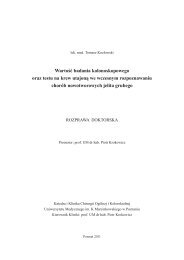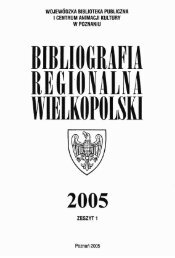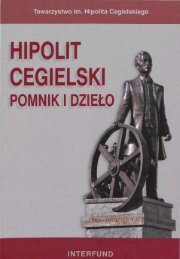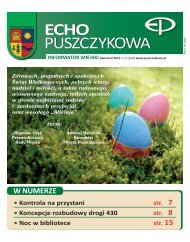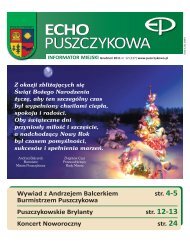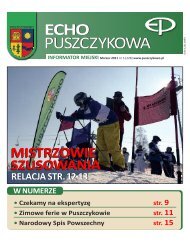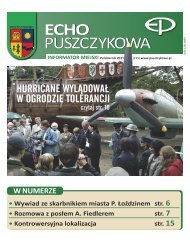© Military Pharmacy and Medicine • 2012 • 4 • 108 – 110Preparation of informationDuring a rescue operation, a lot of informationasked by the media is unpredictable. However,there is still considerable amount of informationthat can be prepared earlier and successivelyreleased to the public. Such information includes:••alarm information;••instructions for behaviour in crisis situations,••data concerning places and sources of informationand help;••data concerning services involved in therescue operation;••appeal to support services in relevantsituations.When preparing rules for cooperation with themedia, all forms of communication should betaken into consideration [10,17]. The most popularforms of communication in crisis situationsinclude: press note, statement, information, telephoneresponse, written response, interview,talk, utterance and press conference.Actions during a crisis situationCommunication with the media during rescueoperations mainly includes: appointment of a24-h duty spokesperson, collection of informationfrom various services, preparation andconveying information to journalists, informationmanagement for the regional and nationalmedia, checking and correction of informationthat was released to the media, organisation ofpress conferences, responding and release ofstatements on the current situation, and coordinationof journalists work in the area involved inrescue operations.It is important to establish an information centrenear the place of rescue actions [3,4,9]. Personsresponsible for contact with the mediashould all the time monitor the situation andrespond immediately to the needs reported bythe media, if it is possible and not against the rescueoperation.Another important element regarding participationof the media in a crisis situation is to separateand adapt for journalists the area aroundthe event site. This area is separated accordingto two important principles. The first of them isReview articlethe superiority of rescue operations interest. Thisprinciple forbids the media to enter places, whereit could pose a risk to the rescue action or to themedia. The second principle, used while separatingareas for the media during catastrophe, isthe best possible availability of the media. Themedia should have possibly the best, acceptable“viewpoint” for observation of the rescue actions,to assure that when looking for a good place fortaking pictures the media will not hinder actionstaken by emergency services.Persons responsible for contacts with the mediaare obliged to separate such areas, in agreementwith persons in charge of the rescue operation.Actions after eliminatinga crisis situationAfter termination of the rescue actions, personsresponsible for contacts with the media areobliged to inform the local community about thecurrent situation and taken precautions, and toinform the entire country about a situation in theparticular region.Unfortunately, it is often seen that the end of therescue operation is the end of all actions aimed toeliminate a crisis situation. However, it should bean introduction to preparations connected withfuture actions. Conclusions should be drawnfrom all experiences, regardless of whether theywere positive or negative; all actions should alsobe thoroughly analysed. Efforts put into analysingthe particular action should help revisearrangements and prepare for future events.SummaryWhen analysing this paper, it may be hypothesizedthat the public authorities, emergency servicesand mass media are all responsible for reliableconveying the current information in crisissituations.However, cooperation with the media is not easy.Journalists are characterised by natural scepticism.They are more interested in criticising theservices and government authorities responsiblefor controlling the crisis situation than in defendingor justifying such services and authorities.Probability of negative comments given by themedia during a crisis situation is almost 100%.108 http://military.isl-journals.com
© Military Pharmacy and Medicine • 2012 • 4 • 109 – 110Although several acts, including the Act on thestate of natural disaster and crisis management,imposed on the media an obligation to reportany threat (in agreement with the local authorities),we should remember about the role of theway how information reaches editorial offices.Thus, it is important to work out methods ofŁukasz Szarpak: Selected aspects of communication between emergency services …presentation to the media a problem of catastropheor emergency.Taking the above-mentioned actions increasesthe chances for peaceable, and at the sametime, effective participation of journalists in acrisis situation.References:1. Beaudoin, C. E. “Assessment of a media campaign andrelated crisis help line following Hurricane Katrina.”Public Health Rep. 123.5 (2008): 646-51.2. Arnold, J. L. “Disaster myths and hurricane Katrina2005: can public officials and the media learn toprovide responsible crisis communication duringdisasters?” Prehosp.Disaster.Med. 21.1 (2006): 1-3.3. Ng, K. H. and M. L. Lean. “The fukushima nuclearcrisis reemphasizes the need for improved riskcommunication and better use of social media.”Health Phys. 103.3 (2012): 307-10.4. Barr, P. “Staying connected. Social media put to workwhen disaster strikes.” Mod.Healthc. 41.36 (2011): 33.5. Keim, M. E. and E. Noji. “Emergent use of socialmedia: a new age of opportunity for disasterresilience.” Am.J.Disaster.Med. 6.1 (2011): 47-54.6. Schlecker, M. and E. Hirsch. “Incomplete knowledge:ethnography and the crisis of context in studies ofmedia, science and technology.” Hist Human Sci. 14.1(2001): 69-87.7. McLearn, D. “FDA crisis management and the media.”PDA.J.Pharm.Sci.Technol. 50.3 (1996): 144-46.8. Misterska, E., M. Glowacki, and Z. Wlodarczyk.“Mass-media and the transplantation crisis: theexample of Poland.” Med.Sci.Monit. 16.8 (2010):RA171-RA176.9. Petriuk, V. A. and E. I. Pokrovskaia. “[Role of the massmedia in eradication of the consequences of a naturaldisaster in summer 2002 in Karachai-ChercassianRepublic].” Zh.Mikrobiol.Epidemiol.Immunobiol.6(2003): 124-26.10. Rich, E. “’I see her being obesed!’: Public pedagogy,reality media and the obesity crisis.” Health (London)15.1 (2011): 3-21.11. Uchwała Senatu Rzeczypospolitej Polskiej z dnia10 grudnia 1997 r. w sprawie obchodów 50 rocznicyuchwalenia Powszechnej Deklaracji Praw Człowieka(M.P. 1997 nr 85 poz. 851).12. Ustawa z dnia 26 stycznia 1984 r. Prawo prasowe(Dz.U. 1984 nr 5 poz. 24).13. Ustawa z dnia 26 kwietnia 2007 r. o zarządzaniukryzysowym (Dz.U. 2007 nr 89 poz. 590).14. Ustawa z dnia 18 kwietnia 2002 r. o stanie klęskiżywiołowej (Dz.U. 2002 nr 62 poz. 558).15. Stokstad, E. “Gulf oil disaster. Hunting for plumes,learning to live in a media spotlight.” Science 329.5987(2010): 22-23.16. Saxena, D. B., H. M. Shah, and P. Mishra. “Mediaresponse to disaster.” Indian J.Med.Sci. 63.1 (2009):28-29.17. Spence, P. R., et al. “Media use and information needsof the disabled during a natural disaster.” J.HealthCare Poor Underserved 18.2 (2007): 394-404..http://military.isl-journals.com109



